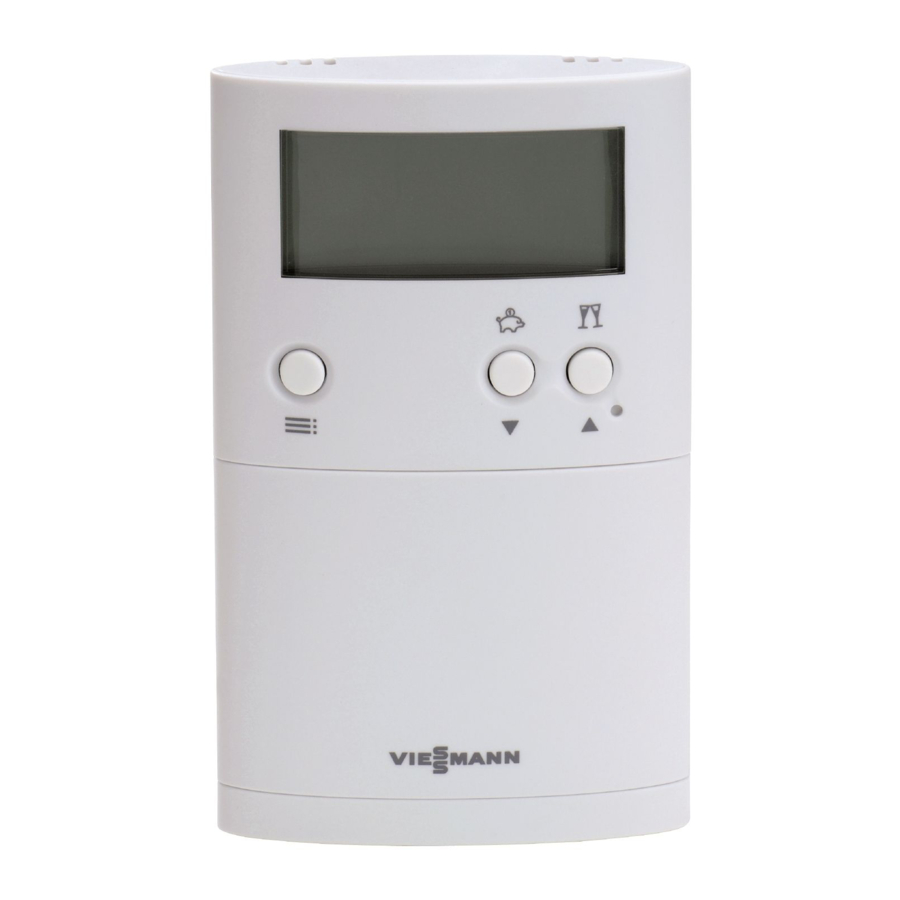
Viessmann VITOTROL 100 Installation Instructions Manual
Hide thumbs
Also See for VITOTROL 100:
- Operating instructions manual (36 pages) ,
- Operating instructions for the system user (36 pages) ,
- Installation instructions for contractors (20 pages)
Table of Contents
Advertisement
Advertisement
Table of Contents

Summary of Contents for Viessmann VITOTROL 100
- Page 1 VIESMANN Installation instructions for contractors Vitotrol 100 Type UTD-RF Clock thermostat with two digital time switches and wireless receiver for the Vitodens 100-W, type WB1B Part no: 7296 065 VITOTROL 100 Dispose after installation. 5355 253 GB 2/2008...
-
Page 2: Safety Instructions
Safety instructions Please follow these safety instructions closely to prevent accidents and material losses. Safety instructions explained the Code of Practice of relevant trade associations, Please note all current safety regulations as This symbol warns against the defined by DIN, EN, DVGW, TRGI, risk of material losses and TRF, VDE and all locally applicable environmental pollution. -
Page 3: Before Installation
Before installation Function Through its integral room temperature sensor and in conjunction with the wireless receiver, the Vitotrol UTD-RF achieves a constant room tempera- ture. Within the selected periods, the control unit changes over between standard operation with the standard room temperature and operation with reduced room temperature. -
Page 4: Installing The Wireless Receiver
Installing the wireless receiver Opening the control unit casing Please note Electronic modules can be damaged by electrostatic dis- charges. Touch earthed objects, such as heating or water pipes, to dis- charge static loads. - Page 5 Installing the wireless receiver (cont.) Installing the wireless receiver 1. Remove the cover from the control 3. Insert the wireless receiver into the unit support. control unit support. 2. Push the wireless receiver cable through the opening in the control unit support.
-
Page 6: Fitting The Clock Thermostat
Installing the wireless receiver (cont.) 4. Insert the wireless receiver cable 5. Close the control unit casing and into the control unit casing and flip up the control unit. push the plug onto terminal "X7". The plug must click home. Fitting the clock thermostat Power is supplied by batteries (see chapter "Specification"). - Page 7 Fitting the clock thermostat (cont.) Alternatively, the clock thermostat can also be positioned as freestanding unit with the plinth supplied.
- Page 8 Commissioning the clock thermostat 1. Open the battery compartment. to confirm. 2. Remove the paper strip. for time and date. Press the following keys: to confirm. 3. RES Reset button for language.
-
Page 9: Wireless Receiver Commissioning
Wireless receiver commissioning Several clock thermostats and the wireless receiver can be installed in a single building. Both are matched up to each other in the factory. If several clock ther- mostats with wireless receiver are fitted inside a single building complex, never interchange the respective clock thermostats and their dedicated wireless recei- vers. - Page 10 Wireless receiver commissioning (cont.) Testing switching outputs 1. Press C at the wireless receiver 3. Terminate the function: (see diagram on page 10) Press C at the wireless receiver The LED " " indicates the switch- ing state: automatic if the switching output is LED ON: Output "ON"...
-
Page 11: Specification
Specification Clock thermostat Rated voltage 2 batteries LR 6 Ambient temperature during operation 0 to 50 °C during storage and transport -10 to 60 °C Protection IP 20 to EN 60529; Shut-off function RS type 1B Wireless receiver Reception frequency 868 MHz Power supply from the control unit... - Page 12 Viessmann Werke GmbH&Co KG Viessmann Limited D-35107 Allendorf Hortonwood 30, Telford Telephone: +49 6452 70-0 Shropshire, TF1 7YP, GB Fax: +49 6452 70-2780 Telephone: +44 1952 675000 www.viessmann.com Fax: +44 1952 675040 E-mail: info-uk@viessmann.com...













